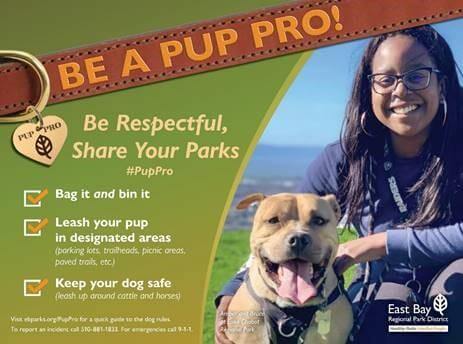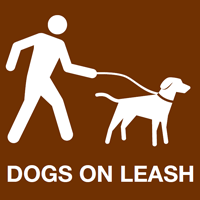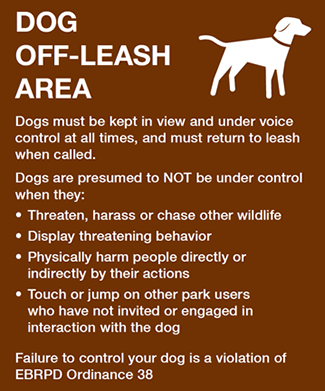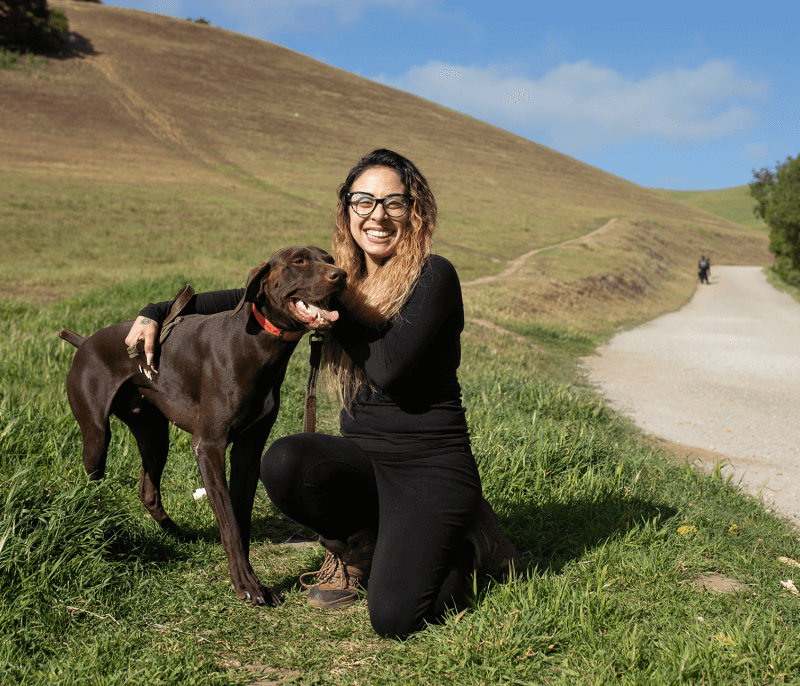The Park District is proud to be one of the most dog-friendly organizations in the nation. We need dog owners’ help to keep parks and trails environmentally safe for everyone.
| Standard Leash Notice Leash Required Areas (Developed Areas). No person shall bring into, or permit any dog, cat, or animal, to enter any Developed Area or be within 200 feet of any parking lot, trail head or staging area, as posted, unless such animal is securely leashed and under control of that person. |
BRING YOUR TRASH HOME and ALL BAGS OF DOG WASTE. NO EXCEPTIONS. Do not litter the trails.

Be Respectful, Share Your Parks #PupPro
- Bag it and bin it
- Leash your pup in designated areas (parking lots, trailheads, picnic areas, paved trails, etc.)
- Keep your dog safe (leash up around cattle and horses)
Hiking with Dogs in the Parks
Before you leave home
- Read General Rules about hiking with dogs
- Bring enough water for you and your dog(s).
- Bring snacks and toys if needed.
- Make sure you have a leash (six-foot maximum) for each dog, and a harness.
- Bring doggie waste bags - better to bring several, just in case.
- Know your dog’s limits - how far can your dog can go before tiring?
- Check the weather where you plan to hike. On warmer days, walk shaded routes and avoid going out during the hottest times of the day.
At the trailhead and during your hike
Upon arrival at the trailhead or parking area, keep your dog(s) on-leash -- dogs must be leashed in all parking lots, picnic areas, developed areas such as lawns and play fields, and on some trails. They must be under voice control at all times. Read the posted dog rules. They must also remain on-leash 200 feet in from the trailhead or park entrance, which allows a "cooling off" period for your pet excited to be outdoors.
During your walk, watch for signs of thirst, hunger, and fatigue. You know your dog best, so pay attention to the telltale signs that only you may know.
On the trail, take rest stops for yourself and your buddy. Dogs appreciate some time in the shade to cool off, too.
Very important! If your dog deposits waste along the trail, pick it up in your dog waste bag or one provided at the park. Please take it with you - do not leave it on the side of the trail. These bags are often forgotten and remain for someone else to pick up. Everyone likes to see a clean park, so please do your part.
Be sure to keep your dog close, there are many dangers for dogs in the parks. They can also transmit poison oak to their owners if they are allowed to romp off trail. Be aware that many people are afraid of dogs despite an owner's belief that their dog is a friendly one. And many people do not appreciate an uncontrolled and overly friendly dog jumping on them or their children.
General Park Rules for Dogs

- Dogs must be leashed (six-foot maximum) and under control at any posted area, parking lot, picnic site, lawn, or developed area and all areas where grazing animals are present.
• See "Where must my dog be on-leash?" in the Frequently Asked Questions section for a complete list of areas that your dog(s) must be leashed.
• See All areas where grazing animals are present. - No dogs or other animals are permitted at any swimming pool, beach, wetland or marsh, or designated nature study area.
- Owners must always carry a leash (six-foot maximum).
- Dogs may be off-leash in open space and undeveloped areas of parklands, provided they are under control at all times.
• See "When is a dog considered under control?" in the Frequently Asked Questions section for an explanation of when your dog(s) are considered to be "under control".
• Undeveloped areas are not posted and unpaved trails or open space areas that are separated from developed areas by a distance of at least 100 yards or by fences. - Dangerous animals are not allowed in the parks.
- Dogs must not be allowed to interfere with, bother, or harass park users, other animals, or wildlife. If you are a party to a dog bite or dog attack incident, you must stop and offer assistance and exchange information with the other party/parties.
- You must remove your dog's waste from all park property and dispose of it in a garbage can or carry it out of the park. DO NOT LEAVE DOG WASTE IN PLASTIC BAGS ALONG THE TRAILS. This is considered littering. For your convenience, plastic bags are provided in many parks and along some trails, but as a precaution, please carry extras with you.
- Any person who walks or exercises a dog or dogs for a fee or who walks more than three (3) personal dogs must obtain and have in their possession a revocable annual permit; please call (510) 690-6508 for information.
Download: List of trails approved for walking up to six dogs. [PDF] - Animals may not be left unattended at any parkland.

Dog Off-Leash Area
Dogs must be kept in view and under voice control at all times and must return to leash when called. Dogs are presumed to NOT be under control when they:
- Threaten, harass or chase other wildlife
- Display threatening behavior
- Physically harm people directly or indirectly by their actions
- Touch or jump on other park users who have not invited or engaged in interaction with the dog
Failure to control your dog is a violation of EBRPD Ordinance 38.
Safety Tips for You and Your Dog
- Keep your dog(s) out of streams and away from shorelines. Dogs that consume raw/uncooked salmon and trout are at risk of infection by "Salmon Poisoning Complex." The bacteria carried by a parasitic trematode worm may cause death in infected dogs. The disease is found in members of the salmon and trout family along the western slopes of the Sierra and Cascade mountains of California, Oregon and Washington, and can be found in ocean-going salmon as well as rainbow trout stocked in Bay Area lakes. Dogs that consume raw/uncooked trout or salmon that carry the bacteria often develop fever, vomiting, diarrhea and enlarged lymph nodes within 5-7 days. If not treated by a veterinarian, the dog may die. What to do:
- Do not allow your dog(s) into any stream or shoreline areas.
- See the Blue-Green Algae Updates page for updates.
- Do not let your dog eat any part of raw/uncooked salmon or trout.
- If you believe your dog has consumed raw/uncooked salmon or trout, contact your veterinarian immediately.
- Choose a hike within the limits of your dog's ability. Dogs, like people, need to be in condition for exercising. Start slow. Do not ask your dog to do too much too soon. For an older dog or a dog with arthritis, or any other medical problem, a long hike is not fun and can be dangerous. Keep in mind that dogs are sprinters by nature. They are not built for long-distance running. Your awareness will play a big role in the success of your outing.
- Carry water for your dog. Always carry water for your dog. Your dog will need a lot for summer hikes. Water from streams or ponds is not always available, and not always safe to drink. We recommend carrying a lightweight plastic container.
- Restrict exercise in the heat of the day. Hike in the shade, where possible. Carry water for your dog. Heatstroke is a great danger to dogs during the summer, they do not eliminate heat as efficiently as humans. When the air temperature is close to body temperature, cooling by rapid breathing is not effective. Dogs need cool air to exchange for warm air. If the air becomes as warm as the dog's body temperature, normally 102.5°, it will continue to rise. If it exceeds 106°, heatstroke could result causing seizures, organ damage, and death. If you come across an animal who is suffering from heat exhaustion (which begins with rapid, noisy breathing), lower its body temperature immediately by soaking with cool water. Then take the dog to a vet as soon as possible. On an average 75° day, the temperature in a car can rise to a deadly 120° within half an hour. Leaving the windows open a crack or parking in the shade does little to alleviate the heat. It is against the law to leave dogs in parked cars in extreme temperatures and/or without adequate ventilation.
- Check before the hike to see that your dog's nails are medium-length. Long nails will make your dog's feet hurt. Short nails interfere with traction.
- Check for and treat cracking, punctures, or sores on foot pads. Your dog needs to have tough pads. If he lives and walks only on soft grass, he might have a problem hiking on trails that may be hard or rocky. A dog's pads should be rough and look like fine sandpaper. Worn-down pads that need treatment are smooth and may have little "dots" on them. The dots are nerve and capillary (blood supply to the pad) endings.
- Check for and remove foxtails and other weeds. Be sure to check the head, neck ears, eyes, nose, mouth, genitals, and between the toes. If your dog repeatedly shakes its head, a foxtail may have entered the ear canal. Sneezing may indicate that a foxtail is in the nasal passage. Repeated licking or scratching in the same area may be due to an embedded foxtail. If you suspect a foxtail, promptly get your dog to a veterinarian.
- Check for ticks after every hike. Check your dog during and after each hike. Pay particular attention to the ear/neck area and the underbelly. If you find ticks crawling on your dog, remove them while wearing plastic gloves or brush them off and crush them. Try not to touch them with your bare fingers. If you find a tick embedded in your dog, remove it with a tick removal tool without squeezing it. Ticks carry a variety of diseases that dogs can catch, including lyme disease that is carried by the Western Black-Legged Tick (Ixodes pacificus). If you wish to have a tick identified, contact the Alameda County Vector Control at 567-6800 to see if it is a carrier of lyme disease. Save in whole and live, if possible, in a covered container, with a moist cotton ball so it does not dry out. Tick prevention measures are available for your dog. Check with your pet professional.
- Stay on the trails and out of brush. Dogs can transmit poison oak to you. Avoid ticks, foxtails, and poison oak by staying on the trails and keeping your dog on the trails. Download the District flyers about snakes, ticks, poison oak and other wildlife encounters and the Common Snakes brochure.
Trail Manners for You and Your Dog
- Respect wildlife and their habitat - you are in their home.
- Respect the environment - don't let your dog dig or cause damage.
- Clean up after your dog. Leave all trails as clean or cleaner than when you arrived.
- Yield the right-of-way to other hikers. Many people are afraid of dogs. Communicate with others and always keep your dog under control.
- Yield the right-of-way to equestrians. Move off the trail far enough to allow horses to pass. Keep you dog close to you, quiet and under control.
- Always be courteous. Don't give other trail users any reason to complain. Set an example for others by being a conscientious owner with a well-behaved dog out enjoying the trails.
Resources
Pet First Aid/CPR
Sign up for instructional dog classes.
Point Isabel Regional Shoreline
Visit the most dog-friendly park in the District.
Ordinance 38
See specific parks or areas of parks where dogs are prohibited by regulation.
Dog Permit
Find out when you will need a permit and how to get it

